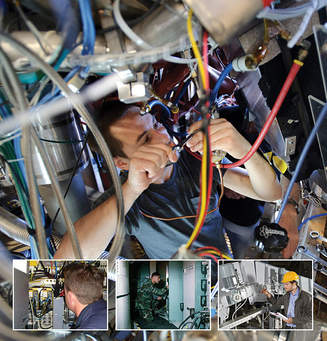(EIM) Electrical Installation and Maintenance

- specialized construction work that is performed during the erection or reconstruction of buildings or structures intended forvarious purposes and that entails the installation of electric wiring and electrical equipment. The electric wiring may beoverhead power lines, cable lines, current leads, or interior wiring. Examples of electrical equipment include electricmachinery, distribution centers, and control consoles. In the USSR, electrical installation work is usually carried out in twostages.
The first stage, which coincides in time with general construction work, includes the installation of fasteners or inserts instructural elements for the subsequent attachment of electrical equipment and structures for the installation of electric wiring.It also includes the installation of conduits for electric wiring in the foundations and floors of buildings or structures and theinstallation of wall sockets for outlets and switches. In the first stage, the preassembly of electrical equipment and wiringstructures, the fabrication of conduit sections, and the board lacing of wires and cables for lighting and other circuits arecarried out away from the construction site in specially equipped electrical-installation prefabrication shops.
In the second stage, the electrical equipment and the structures for the installation of wiring are transported to theconstruction site, installed in the planned locations, and assembled. In addition, cables and wires are laid and are connectedto the installed electrical equipment. Electrical installation work is completed when the installed equipment is actuated andadjusted. The most complicated work in this respect is the adjustment of relay protection and automatic control systems forelectric drives.
Electrical installation work is mechanized through the use of general-purpose construction machinery—for example, lifttrucks, hoists, and truck cranes—and of specialized electrical-installation machinery, devices, and tools.



